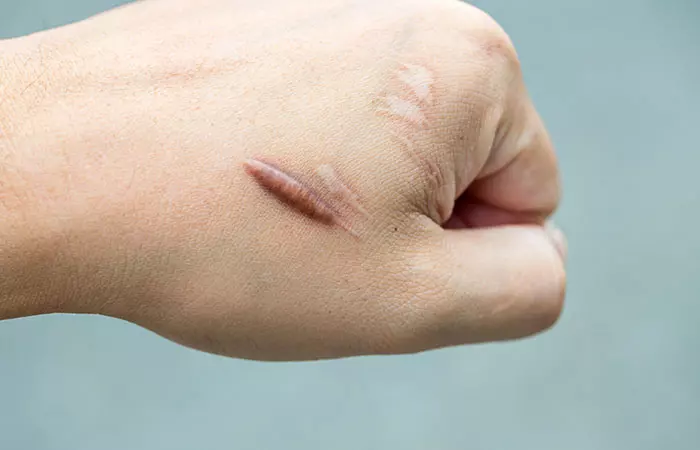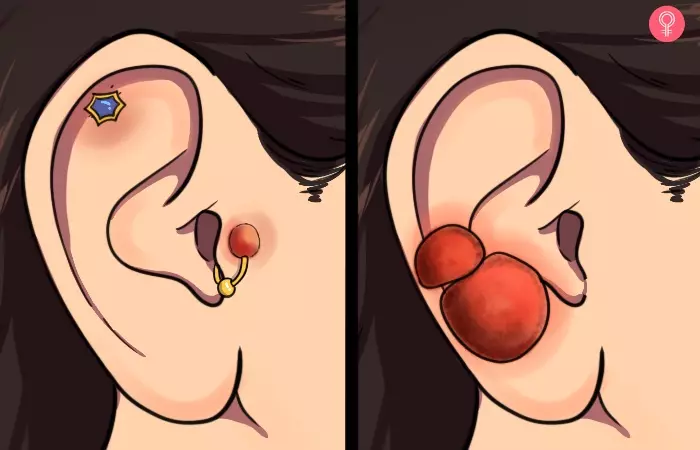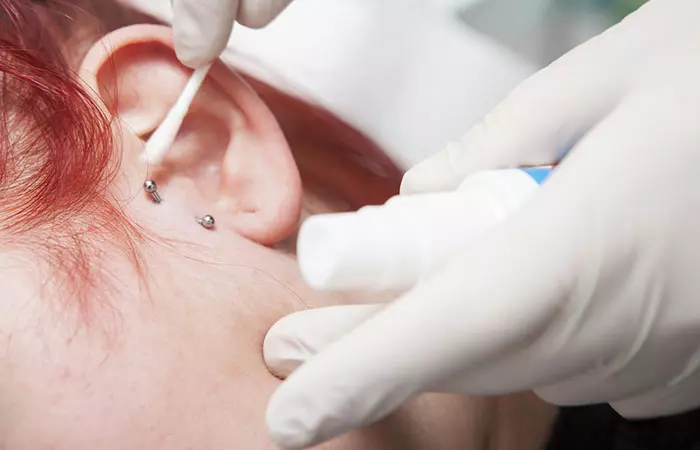What Is A Piercing Bump?
So you have got a little bump hanging around your new piercing. It might be worrying, but before you jump to conclusions, let us discuss what it is. A piercing bump is a localized inflammation triggered by factors such as irritation, improper cleaning, and sometimes, just your body getting used to the new jewelry. It may be your body’s natural response to the “wound” created by the piercing, similar to how you get a scab after a scrape. A piercing bump can look like little red or white pimples, and it is typically tender to the touch. It is quite common, usually harmless, and treatable. However, it is essential to address it promptly. With proper care, you can get rid of it and keep your piercing healthy. While recognizing a piercing bump is the first step, understanding its symptoms and causes is important. The next section sheds light on the various signs to watch out for, along with the potential triggers that might be causing the nasty bump.
What Are The Symptoms And Causes Of A Piercing Bump?
Here are some of the common symptoms and causes of a piercing bump.
Symptoms
Causes
Lintonia Winona, a blogger, revealed her nose-piercing ordeal due to a mishap involving her glasses. She wrote in her blog, “Literally 3 weeks in…my glasses slid off my nose, caught my nose ring! Ouch! (i)”. Despite initial success with a sea salt mask to manage the piercing bump that resulted from it, she recounted, “it came back a few weeks later, not trauma-induced, just unhappy, I guess.” We have unpacked the symptoms and causes of a piercing bump. But our work is not done yet. It is important to differentiate it from its more persistent cousin: keloid. Keep reading to understand if your temporary bump might be something else entirely.
What Is A Keloid?
Sometimes, a bump can morph into something more serious – a keloid. Think of a keloid like an overenthusiastic scar. Typically, the appearance of scar tissue fades over time, but a keloid keeps growing and forms a smooth, raised bump that extends beyond the original wound. This can happen after any injury or piercing, but people with darker skin tones may be more prone to them (1). Instead of a nice and neat type of scar, your body might go into overdrive and produce too much collagen during the healing process. This surplus collagen leads to the formation of a keloid (1). It is a raised, thickened, and sometimes itchy mass of tissue. They can be a bit annoying because they extend beyond the original injury site, unlike typical scars (hypertrophic scars) that tend to stay within the boundaries of the wound. They can sometimes keep growing even after the wound has healed. Keloid scarring is most common in areas with minimal fatty tissue, like the chest, shoulders, and earlobes (1). So, you may notice a keloid near body piercings like cartilage piercings, earlobe piercings, etc. And they can range in size from a small bump to a more substantial, noticeable growth. This overgrowth of scar tissue is not harmful in a health sense, but it may cause a cosmetic issue (1). Some people do not mind them at all, while others might find them bothersome. Keloids might sound scary, but understanding their symptoms and causes can ease your worries. Continue scrolling to learn more.
What Are The Symptoms And Causes Of A Keloid?
Here are some common symptoms and causes of keloids.
Symptoms
Causes
Do not let bumps confuse you! The next section acts as your personal guide, dissecting the key differences between piercing bumps and keloids.
Piercing Bump Vs. Keloid: Key Differences
While both piercing bumps and keloids can appear after getting your ears adorned, understanding their key differences is important. Here are some of the distinguishing features that can help you determine what you are dealing with and navigate the best course of action: Ready to banish those pesky bumps for good? Keep reading to learn about treatments for piercing bumps to achieve smooth, bump-free piercing.
Treatment For A Piercing Bump
While piercing bumps might be concerning, they are quite common and often treatable. Here are some general tips to help you manage them:
Use a mild, fragrance-free sterile saline solution or a product recommended by your piercer to clean your piercing twice a day. Avoid harsh soaps, alcohol, or antibacterial products. Also avoid harsh chemicals, cosmetics, and hair products that could irritate your piercing. Use antiseptic solutions to deal with infected piercings and painless bumps. Chamomile tea has been suggested by some individuals as a potential home remedy for soothing piercing bumps. Soak a warm chamomile tea bag in warm water and then apply it as a compress to the affected area. Do not touch, twist, or play with your piercing, as this can irritate it further. After cleaning, pat the area dry with a clean, lint-free gauze or paper towel. Apply a warm compress made with clean water for 5-10 minutes, 2-3 times a day. Mix 1/4 teaspoon of sea salt with a cup of warm water and soak your piercing for 5-10 minutes, 1-2 times a day. Wear loose-fitting clothing around your piercing to avoid snagging and friction.
So, this is how to get rid of piercing bumps through gentle care. Both piercing bumps and keloids have treatment options, but they differ. Continue scrolling to discover strategies and treatments you can employ to deal with keloids on your piercings.
Treatment For A Keloid
Here are some treatments for keloids. However, consult a board-certified dermatologist or a healthcare practitioner to understand your options and for personalized treatments.
Corticosteroid injections can help reduce inflammation and shrink the keloid. Applying silicone gel sheets to the keloid for several hours daily may help flatten and soften it. Freezing the keloid with liquid nitrogen as mediated in cryotherapy can be effective for smaller ones. Different types of lasers can target and reduce the keloid tissue. In severe cases, surgical removal might be an option, but keloids can recur even after surgery.
Can a bump turn into a keloid? Yes, a bump near a piercing can potentially evolve into a keloid. Especially if there is a predisposition or if the area is continuously irritated. How long does a piercing bump last? The duration varies, but with proper care instructions, most piercing bumps improve within a few days to weeks. However, persistent bumps may require professional attention. Do keloid bumps from piercings go away? Keloids are often persistent and may not resolve on their own. Treatment options like steroid injections or surgical procedures may be considered. Should I remove my piercing when I have a keloid? Removing the piercing might not necessarily eliminate the keloid. Consult with a healthcare professional for personalized advice on managing the keloid while preserving the piercing. Will the bump on my piercing heal on its own? In many cases, with proper care, piercing bumps can improve and heal on their own. However, persistent or worsening bumps should be assessed by a professional. Are keloids soft or hard? Keloids typically feel firm or hard to the touch due to an excess of collagen. How long does it take for a keloid to form? Keloids can form gradually during the healing process, and their development timeline varies. Hence, it is essential to monitor any unusual skin growth after an injury or piercing. Curious about mysterious bumps on your piercings? Watch the following video for expert insights on causes and solutions for the issue, as it explains the difference between harmless bumps and keloids.









